American beech
(Fagus grandifolia grandifolia)

Description
Fagus grandifolia grandifolia, commonly known as the American beech, is a deciduous tree that belongs to the family Fagaceae. This tree is native to North America, and it is found in the eastern United States and Canada, from Nova Scotia to Florida, and as far west as Texas and Minnesota. The American beech is a tall and stately tree that can reach heights of up to 80 feet with a trunk diameter of 3 to 4 feet. In this article, we will discuss the American beech's physical characteristics, habitat, uses, and more. Physical Characteristics of Fagus grandifolia grandifolia The American beech has a smooth, light gray bark, which develops rough scales as it ages. The tree has a broad, spreading canopy, and its leaves are alternate, simple, and ovate in shape. The leaves have a pointed tip, and they are 2-5 inches long and 1.5-4 inches wide. The leaves are dark green in color during the growing season, but they turn a golden yellow in the fall. The American beech produces a fruit called a nut, which is enclosed in a spiny, woody husk. The nuts are edible and are an important food source for wildlife, including squirrels, chipmunks, and birds. Habitat and Distribution of Fagus grandifolia grandifolia The American beech is a common tree in the eastern United States and Canada, and it is found in a wide range of habitats. The tree is typically found in deciduous forests, but it can also be found in mixed forests and on rocky slopes. The American beech prefers well-drained soils and is often found growing on ridges and hillsides. The tree can grow in full sun or partial shade. Uses of Fagus grandifolia grandifolia The American beech has a variety of uses, both ecological and cultural. The tree is an important food source for wildlife, and its nuts are also edible for humans. The wood of the American beech is hard, strong, and close-grained, making it useful for a variety of purposes. The wood is commonly used for flooring, furniture, veneer, and tool handles. The bark of the American beech contains tannins, which are used in the tanning of leather. The tree also has cultural significance, as it has been used by Native Americans for medicinal purposes and for making baskets and other crafts. Threats to Fagus grandifolia grandifolia The American beech is threatened by a number of factors, including disease, climate change, and human development. One of the most significant threats to the American beech is beech bark disease, which is caused by a combination of an insect and a fungus. The disease has killed millions of American beech trees in the eastern United States and Canada. Climate change is also a threat to the American beech, as changes in temperature and rainfall patterns can affect the tree's growth and distribution. Human development, such as logging and urbanization, can also have a negative impact on the American beech's habitat. Conservation Efforts for Fagus grandifolia grandifolia Conservation efforts for the American beech are ongoing. One of the most important conservation measures is the development of resistant strains of the tree that are immune to beech bark disease. Research is also being conducted to better understand the tree's ecological requirements and to identify areas where the tree is most vulnerable to human development. Efforts are also underway to protect and preserve the American beech's habitat through land conservation and management programs. Conclusion Fagus grandifolia grandifolia, or the American beech, is a majestic and important tree.
Taxonomic tree:







